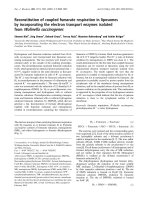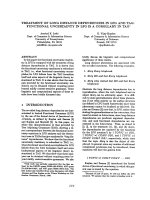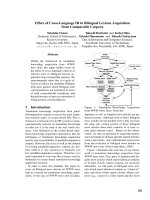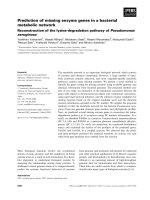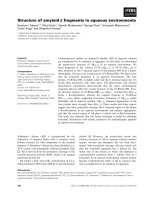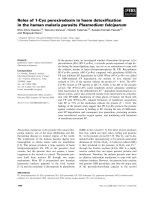Báo cáo khoa học: "iomass of root and shoot systems of Quercus coccifera shrublands in Eastern Spain" pptx
Bạn đang xem bản rút gọn của tài liệu. Xem và tải ngay bản đầy đủ của tài liệu tại đây (58.76 KB, 8 trang )
Original article
Biomass of root and shoot systems
of Quercus coccifera shrublands in Eastern Spain
Isabel Cañellas Rey de Viñas
a,*
and Alfonso San Miguel Ayanz
b
a
Dpto Selvicultura, CIFOR-INIA, Ap.8.111, 28080 Madrid, Spain
b
Dpto. Silvopascicultura, E.T.S.I. Montes, Ciudad Universitaria, 28040 Madrid, Spain
(Received 12 October 1999; accepted 14 February 2000)
Abstract – Belowground and aboveground biomass of kermes oak shrublands (Quercus coccifera L.), an evergreen sclerophyllous
species common in
garrigue communities in Spain, have been studied by controlled excavation and harvesting. Aboveground bio-
mass has been measured on 320 1-m
2
plots. Total biomass varies with age and ranges between 0.4 (7 months) to 2.8 kg m
–2
D.M.
(> 40 year), and leaf biomass increases with age until 6–8 years (0.56 kg m
–2
D.M.) and then decreases and reaches a steady state
around 0.35 kg m
–2
D.M. (> 40 year). Total belowground biomass ranges from 34 to 81 mg ha
–1
D.M., including rhizomes and ligno-
tubers. Roots and rhizomes were concentrated in the uppermost 15 to 35 cm of the soils. The root area always exceeded the shoot
area. The average dry weight root:shoot ratio was 3.5, ranging from 2.61 to 4.73. It is quite higher than that of other Mediterranean
ecosystems.
Kermes oak / productivity / Quercus coccifera / shoot biomass / root biomass / root:shoot ratio
Résumé
– Biomasses des systèmes souterrains et aériens des garrigues de Quercus coccifera de l’Est de l’Espagne. Les bio-
masses souterraines et aériennes de
Quercus coccifera, espèce arbustive et persistante assez courante dans les garrigues espagnoles,
ont été mesurées au moyen de techniques d’excavation et de coupe. La biomasse aérienne a été mesurée sur 320 placettes de 1 m
2
chacune. La biomasse totale change avec l’âge, en prenant des valeurs qui varient entre les 0.4 kg m
–2
M.S. (à l’âge de 7 mois) à
2.8 kg m
–2
(> 40 années). De même, la biomasse foliaire augmente avec l’âge jusqu’à 6–8 ans (0.56 kg m
–2
M.S.), et diminue ensuite
en prenant des valeurs très proches de 0.35 kg m
–2
M.S. (> 40 années). La biomasse souterraine, y compris les rhizomes, varie entre
34 et 81 mg ha
–1
M.S. Les racines et les rhizomes étaient concentrés dans la partie la plus superficielle du sol (jusqu’à 15–35 cm
d’épaisseur). L’extension des racines débordait toujours de la projection au sol de la partie aérienne. La moyenne du rapport poids
sec biomasse souterraine/biomasse aérienne était égale à 3.5 en variant de 2.71 à 4.73; ces valeurs sont un peu supérieures à celles
trouvées pour d’autres écosystèmes méditerranéens.
chêne Kermès / production / Quercus coccifera / biomasse aérienne / biomasse souterraine / rapport biomasse souterraine/
biomasse aérienne
1. INTRODUCTION
An accurate assessment of shrub biomass is important
for the evaluation of the productivity of ecosystems, and
their cycling of nutrients and carbon. In shrubland
Mediterranean ecosystems, information on aboveground
biomass, shrub size and structure is scarce, and relevant
estimation methods are not very well known. There are
only a few studies of this type in Spain [6, 7, 9, 37]. In
contrast, there is more information in other countries and
Ann. For. Sci. 57 (2000) 803–810 803
© INRA, EDP Sciences
* Correspondence and reprints
Tel. (34) 913 476 867; Fax. (34) 913 572 293; e-mail:
I. Cañellas Rey de Viñas and A. San Miguel Ayanz
804
similar ecosystems [4, 5, 24, 35, 42]. This research con-
centrates on tree communities [12, 13, 38, 43, 44].
Compared with the relative abundance of information
on aboveground standing crops, belowground informa-
tion is limited. Root systems are an important fraction of
plant biomass and play a significant role in forest net pri-
mary production [27]. This component is frequently
more important than aboveground biomass in the miner-
al turnover process [15]. Although plant roots have been
studied in their morphological and physiological aspects
for a long time, little is known about characteristics such
as the size of the roots systems, root growth rates under
field conditions, interrelations among root systems of
different plants species, root turnover rates, and so on.
Although scientists recognise the important role of
these biomass fractions, the studies are scarce. This is at
least partially due to the fact that roots, but even more
so, entire root ecosystems, are difficult to observe, that
has made it difficult to develop a reliable methodology
of study. Comparison, generalisation and modelling of
root systems, are very difficult to study due to the scarci-
ty of data, and lack of precision in the methodology
used. Thus there is no global theory which explains the
dynamic and structural relations of root systems in natur-
al ecosystems.
The shrubland Mediterranean American ecosystems
are among the most studied [16, 19, 29, 30]. In Spain,
studies about root biomass and its productivity were
made on grasslands [18], and some forests [14].
However there is not much information on root systems
in shrubland ecosystems [27, 28].
Kermes oak (Quercus coccifera L.) is undoubtedly
one of the most important shrub species in the
Mediterranean Basin, which covers more than 2 million
hectares. It grows under typical Mediterranean climates,
with a considerable summer drought period and on a
great variety of soil types, either on acidic or basic par-
ent materials [6]. In Spain, it is widely distributed along
the Mediterranean coastal provinces and also in the inte-
rior. It plays a very important role in erosion control,
especially after fire, as a fundamental fodder source for
wildlife and livestock (mostly sheep and goats). It is also
an important habitat for small game species, such as rab-
bits (
Oryctolagus cunniculus) and red legged partridge
(Alectoris rufa), which are often the most useful natural
resources of these plant communities from the economic
point of view [6, 7].
There is not very much information on above- and
belowground biomass of Spanish Q. coccifera shrub-
lands but there are more abundant data in other
Mediterranean countries. Long et al. [23] and Rapp and
Lossaint [34] presented the first data about biomass
(shoot and root) and root and shoot ratios in the garrigue
of Southern France. Kummerow et al. [22], Rambal [32]
and Rambal and Leuterne [33] evaluated and analyzed
the characteristics of the root systems of these French
communities. Christodoulakis and Psaras [10] studied the
root anatomy characteristic of Greek kermes oak shrub-
lands; and Arianoutsou [1] and Tsiouvaras [41] have
published some data about shoot and browse biomass.
The purpose of the present study is to contribute with
quantitative data to the generally scarce knowledge of
Q. coccifera root and shoot systems and their ratio.
2. MATERIALS AND METHODS
2.1. The study site
Our study was carried out in Valencia (eastern Spain)
on eight kermes oak shrublands of different ages. The
precise location of our experimental plots, and their main
characteristics are shown in table I.
The climate could be included in the lower meso-
Mediterranean belt and dry ombrotype, according to the
Rivas Martínez bioclimatic typology [36]. The mean
Table I. Main characteristics of Quercus coccifera experimental plots at Valencia (Eastern Spain).
Plot Age at ground Longitude Latitude Elevation Height Slope
base (years) (m) (m) (%)
Acentinela 0.6 0º43' W 39º29' N 360 0.10 15
Moratilla 3.2 0º54' W 39º27' N 805 0.38 5
La Nevera 4.2 0º47' W 39º32' N 450 0.50 30
Requena 4.8 1º00' W 39º25' N 830 0.40 5
La Parra 5.0 0º47' W 39º26' N 600 1.20 30
Venta Moro 7.7 1º20' W 39º28' N 950 0.60 10
Yátova 10.8 0º51' W 39º23' N 605 0.60 10
Hortunas 16.67 1º10' W 39º35' N 600 1.10 25
Buñol > 40 0º45' W 39º24' N 725 1.55 5
Root and shoot systems of kermes oak shrublands
805
annual rainfall is 500 mm, and the average temperature
is 11.1 ºC. There is a possible frost period from late fall
(November) to early spring (March), with an absolute
minimum temperature of –12 °C. The soil belongs to the
Calcic Cambisol–Calcaric Regsol association [11]. The
potential vegetation is an evergreen sclerophyllous for-
est: Bupleuro-Quercetum rotundifoliae with Pistacia
lentiscus [36]. However, due to fire, browsing and other
human impacts, the current vegetation type is a continu-
ous kermes oak garrigue (Rhamno lycioidis-Quercetum
cocciferae).
2.2. Aboveground biomass
Aboveground biomass was measured on 160 (20 sam-
ples × 8 plots) 1-m
2
sub-plots for two years. Each plot
was harvested to ground level and separated into differ-
ent categories: kermes oak leaves, kermes oak stems and
biomass of other species. Some additional variables were
also measured: age (through the date of the last fire,
number of kermes oak stems and dominant height).
Oven dry matter percentage in a fraction was also deter-
mined (48 hours at 105 °C).
The annual increment of aboveground biomass was
calculated dividing the corresponding total biomass by
the years since the last fire.
The dependent variable was tested for normality of
distribution using the Shapiro-Wilk statistic [39]. Data
were used to select biomass equations through non-linear
regression techniques (Marquardt method). The indepen-
dent variable used was age. We considered the age of
shrubland as a number of years since the last fire. The
difference of aboveground biomass of the sites was test-
ed by analysis of variance. Duncan’s test of range multi-
ple has been used when there were significant differ-
ences between sites (95% confidence intervals). The
statistical package SAS [39] was used for analysis.
2.3. Belowground biomass
The roots were harvested on 24 (3 samples × 8 plots)
1-m
2
plots subdivided into three soil layers: 0–15 cm,
15–30 cm and 30–45 cm, although reaching the last layer
was not always possible by the frequent presence of
large rocks. At 45 cm depth, further excavation proved
to be nearly impossible. At this depth, fine roots were
very rare and thicker roots were not very common.
Rocks generally inhibited further vertical penetration.
Roots were extracted from the soil samples by means
of sieving (2 mm) and sorted into diameter classes of
small and fine roots (diameter < 5 mm) and of large
roots (diameter > 5 mm) with rhizomes and lignotubers.
We did not intend to separate living from dead fine roots
because the criteria for such decision was not clear in
field and the live-dead fine root percentage changes
along the year [20, 22]. For this reason the percentage
given by Kummerow et al. [22] about live and dead fine
root biomass has been used. Finally, dry weight for each
root fraction was measured and recorded.
The difference of belowground biomass of the sites
was tested by analysis of variance. Duncan’s test of
range multiple has been used when there were significant
differences between sites (95% confidence intervals).
The statistical package SAS [39] was used for analysis.
Roots of
Brachypodium retusum Boiss., a grass fre-
quent in the repeatedly burned plots, can be distin-
guished morphologically quite well from Q. coccifera
fine roots, and thus be eliminated from the samples.
3. RESULTS AND DISCUSSION
3.1. Aboveground biomass
Results are presented and summarised in the figures 1,
2 and 3 (where each point is the average of 20 data from
1-m
2
plots) and in the table II.
Table II. Predictive equations for total and leaf biomass (n = 20) filled by non linear regression in kermes oak shrublands.
Fraction Parameter SE(a) SE(b) SE(c) RMS
Total biomass a = 0.8339 0.0648 0.0290 - 0.0378
Pt = a·X
b
b = 0.3406
Leaf biomass a = 0.3189 0.0385 0.0889 0.0078 0.0044
Pf = a·X
b
·exp(c·X) b = 0.2866
c = –0.0253
Mean annual total biomass increment a = 0.5522 0.0283 0.0375 - 0.0025
IB = a·X
b
b = –0.4305
Pt: total biomass (kg m
–2
D.M.); Pf: leaf biomass (kg m
–2
D.M.); IB: mean annual total biomass increment (kg m
–2
yr
–1
D.M.); X: Age (yr);
RMS: residual mean square; SE(a), SE(b), SE(c): standard deviation of parameters.
I. Cañellas Rey de Viñas and A. San Miguel Ayanz
806
Total aboveground biomass varies with age (figure 1)
and ranges between 0.4 kg m
–2
D.M. (7 months) and
2.8 kg m
–2
(> 40 year). Our data basically behave like
those presented by Arianoutsou [1], Long et al. [23],
Mooney and Kummerow [21] and Rapp and Lossaint
[34]. However, a faster initial biomass increase has been
observed in our case, and though our maximum limit of
total biomass accumulation (asymptote) seems to be
somewhat smaller, maybe due to our lower rainfall and
rocky calcareous soil.
Mean annual total biomass increment (figure 2) is
high (about 0.6 kg m
–2
) immediately after fire and during
the next 6–8 years. Later it decreases and reaches a mini-
mum of 0.006 kg m
–2
at 40 years after fire.
Leaf biomass also increases with age (
figure 3) until
6–8 years after fire (0.56 kg m
–2
D.M.) and then decreas-
es and reaches a steady state around 0.35 kg m
–2
. These
data are in agreement with those of Malanson and
Trabaud [26] and those of Specht [40], thus confirming
the possible interest of using rejuvenation treatments
Figure 1. Relation between total biomass (kg m
–2
D.M.) and age (years) of Quercus coccifera shrublands at Valencia (Eastern
Spain). Vertical lines indicate mean confidence interval at 95%.
Figure 2. Relation between mean annual total biomass increment (kg m
–2
yr
–1
D.M.) and age (years) of Quercus coccifera shrub-
lands at Valencia (Eastern Spain). Vertical lines indicate mean confidence interval at 95%.
Root and shoot systems of kermes oak shrublands
807
(prescribed fire, browsing, cutting) in order to increase
the extent of browse production and nutritive value of
kermes oak shrublands.
Statistically significant difference between the mean
aboveground biomass and sites, at the 95% confidence
level, has been founded.
Table V shows the results of
Duncan’s test of differences between means of above-
ground biomass.
3.2. Belowground biomass
Although our intensity sampling is bigger that the
other studies carried out in this species [22, 34], the
excavation of 24 m
2
plots of kermes oak shrublands is
not enough to draw many far reaching conclusions.
Nevertheless, the data obtained from this investigation
elucidate the distribution of space between the roots of
kermes oak and quantify its biomass.
The method used (direct excavation) allows us to
determine the characteristics of roots and their colour,
length, size and distribution in the soil stages, but this
method needs a lot of physical work and time [3]. This
makes it difficult to increase the study area.
The total root biomass for the excavated area is pre-
sented in
table III. The dry weight values are subdivided
into root size classes in each of the three soil layers. The
standard deviation of mean is presented in brackets.
Buñol plot, which is the oldest (> 40 years), has the
highest value (81 mg ha
–1
D.M.), while the youngest plot
(2 years) has the lowest one (34 mg ha
–1
D.M.). The
average of the plots we analysed was 53 mg ha
–1
D.M.,
next to some forest ecosystems [34]. The comparison of
the contribution of the two biomass categories to the
total demonstrates the relatively low biomass of small
roots compared to that of larger roots, lignotubers and
rhizomes. Small roots constituted 22.64% of total bio-
mass and the large roots, including lignotubers and rhi-
zomes, constituted 77.36% of total biomass.
While our data might look very high (table IV), they
are in close agreement with studies in Q. coccifera
shrublands of Kummerow et al. [22], Rambal [32] and
Rapp and Lossaint [34].
The results of the analyses of variance for total below-
ground biomass show that there are significant differ-
ences between the youngest and oldest plots, so the bio-
mass in Buñol was significantly greater than that in
either of the most frequently burned stands. Table V
shows the results of Duncan’s test of differences
between means of belowground biomass.
The small roots were concentrated near the surface.
About 54 to 89% of this fraction was found in the upper-
most 15 cm of the soil. Rambal [32] and Kummerow
et al. [21] found that more than 50% of fine roots (diam-
eter < 1 mm) were in the first 10 cm of the soil.
Although the root distribution was mainly concentrated
in the uppermost 20 cm, it also became clear that some
roots penetrated even deeper through the cracks of the
Figure 3. Relation between leaf biomass (kg m
–2
D.M.) and age (years) of Quercus coccifera shrublands at Valencia (Eastern Spain).
Vertical lines indicate mean confidence interval at 95%.
I. Cañellas Rey de Viñas and A. San Miguel Ayanz
808
fissured limestone. Although these roots may be unim-
portant in their contribution to total biomass, physiologi-
cally they are probably highly important because they
attenuate the effects of summer drought. The existence
of a root system that exploits progressively deeper soil
layers with the advance of summer drought has been
reported for
Q. coccifera by Kummerow et al. [21] and
Rambal [32].
The larger conducting roots formed an intricate mesh-
work, and grafts were frequently observed at crossings
not only between roots of the same shrub but also
between individuals growing several meters apart from
each other.
Table III. Belowground biomass of Q. coccifera shrublands, in g m
–2
(D.M.) (standard deviations in brackets).
Sites Soil Diameter classes Total
Depth cm < 5 mm > 5 mm Biomass
Acentinela 0–30 632 (97) 2823 (154) 3455 (113)
Moratilla 0–15 844 (107) 3815 (259) 4659 (352)
15–30 103 (42) 442 (81) 545 (106)
total 947 (115) 4257 (180) 5204 (258)
La Nevera 0–30 961 (97) 4151 (749) 5112 (809)
Requena 0–15 897 (41) 1930 (139) 2827 (159)
15–30 190 (36) 27 (22) 217 (15)
30–45 68 (21) 394 (101) 462 (168)
total 1155 (72) 2351 (252) 3506 (313)
La Parra 0–15 1513 (210) 2574 (434) 4087 (643)
15–30 185 (30) 72 (30) 257 (39)
30–45 58 (16) 86 (16) 144 (28)
total 1756 (223) 2732 (461) 4488 (684)
Venta Moro 0–15 795 (286) 3914 (522) 4709 (731)
15–30 532 (255) 2061 (384) 2593 (633)
30–45 137 (17) 242 (50) 379 (41)
total 1464 (521) 6217 (940) 7681 (1396)
Yátova 0–20 959 (65) 4239 (818) 5199 (851)
Buñol 0–15 985 (120) 5735 (738) 6720 (852)
15–30 144 (17) 678 (65) 822 (75)
30–45 192 (11) 395 (43) 587 (52)
total 1321 (146) 6808 (825) 8129 (961)
Table IV. Belowground biomass data in some Mediterranean
shrublands.
Mediterranean communities Belowground biomass References
mg ha
–1
D.M.
Matorral (Chile) 20.0 [19]
Matorral (Chile) 113.0 [17]
Chaparral (California) 6.8 [17]
Chaparral (California) 18.8 [19]
Mallee (Australia) 13.7 [25]
Low shrublands (SW of Spain) 13.5 [27]
Garrigue (France) 72.0 [22]
Garrigue (France) 46.0 [34]
Garrigue (France) 80–120 [32]
Q. coccifera shrubland (Spain) 34–810 our data
Table V. Above- (S) and belowground (R) biomass and R/S
ratios for Quercus coccifera shrublands at Valencia.
Sites Aboveground Belowground Root/Shoot
biomass (S) biomass (R) Ratio (R/S)
mg ha
–1
D.M. mg ha
–1
D.M.
Acentinela 8.9
a
34.6
a
3.9
La Moratilla 11.0
b
52.0
b
4.7
La Nevera 13.0
bc
51.1
b
3.9
Requena 13.4
c
35.1
a
2.6
La Parra 14.8
c
44.9
ab
3.0
Venta Moro 17.2
d
76.8
bc
4.5
Yátova 19.4
d
52.0
b
2.7
Buñol 31.1
e
81.3
c
2.6
Average 15.1 53.5 3.5
a b c d e
: multiple comparison procedure (Duncan’s test, 95%).
Root and shoot systems of kermes oak shrublands
809
3.3. Root:shoot biomass ratios
The importance of root:shoot biomass ratio for the
assessment of carbon allocation to the root system is
unquestionable [3, 30]. However, the root:shoot ratio is of
questionable value in an environment that burns at more
or less frequent intervals. Burls or lignotubers are clumps
of secondary wood and development from a transition
zone between hypocotyl and main root of seeding plant.
The resprouting shrub species, like Q. coccifera, issued
from large burls, are difficult to identify with respect to
their age, and it is virtually impossible to define the pro-
portions of contribution of root and stem issue.
With these restrictions in mind, root:shoot ratios from
Q. coccifera shrublands were made (table V). Our data
are in disagreement with Barbour’s concept [2] that root
systems from arid areas are not necessarily very large,
but they agree with data on other Quercus shrubs like
Q. turbinella (root:shoot ratio was 3.2) or Q. dumosa
(3.8), both including lignotubers [20].
In other Mediterranean communities this ratio is usu-
ally smaller than ours (
table VI). Perhaps this is the
result of many years of wood-cutting for fuelwood and
charcoal or repeated fires since the volume of burls
increases with age and repeated harvesting of stems.
CONCLUSIONS
Total biomass varies with age and ranges between 0.4
(7 months) to 2.8 kg m
–2
D.M. (> 40 year), and leaf bio-
mass increases with age until 6–8 years (0.56 kg m
–2
D.M.) and then decreases and reaches a steady state
around 0.35 kg m
–2
D.M. (> 40 year). Total belowground
biomass ranges from 34 to 81 mg ha
–1
D.M., including
rhizomes and lignotubers. A comparison of the root den-
sities in the soil beneath the eight stands reveals a sur-
prising fact: quotas for small and large roots, the latter
including lignotubers and rhizomes, did not seem to dif-
fer significantly between stands that are frequently
burned, although the aboveground standing biomass dif-
fered widely (table IV).
The mean dry weight root-shoot (R/S) ratio ranged
from 2.6 to 4.7 (average 3.5). These figures are higher
than those of other Mediterranean ecosystems. This
shows us the important adaptation of the Quercus coc-
cifera shrublands to the Mediterranean region and its
capacity to live in hard climatic and edaphic conditions.
The continuity of belowground biomass after the fire
in this vegetation probably plays an important role in
determining the optimum tactics to be adopted during
succeeding cycles. The retention of a considerable
amount of minerals in the belowground plant compart-
ment [6, 8] which could be partially mobilised after a
fire, allows competing in ecosystems that are usually
very poor.
Acknowledgements: This work was funded by the
Spanish National Institute for Agricultural Research
(INIA), Research Project 8147. We give our acknowl-
edgements to Dr. Irena Trukova (teacher of English in
the Forest School, UPM) for checking this manuscript.
REFERENCES
[1] Arianoutsou M., Post-fire successional recovery of a
phryganic (East-Mediterranean) ecosystem, Acta Oecol. 5
(1984) 387-394.
[2] Barbour M.G., Desert dogma reexamined: root/shoot
productivity and plant spacing, Ame. Midl. Nat. 89 (1973) 41-
57.
[3] Bohm W., Methods of studying root systems, Springer-
Verlag, New York, 1979.
[4] Brown J.K., Estimating shrub biomass from basal stem
diameters, Can. J. For. Res. 6 (1976) 152-158.
[5] Buech R.R., Rugg D.J., Biomass relations of shrub com-
ponents and their generality, For. Ecol. Manage. 26 (1989)
257-264.
[6] Cañellas I., Ecología, características y manejo de mator-
rales
de Quercus coccifera L. en España, Ph.D. Thesis E.T.S.I.
de Montes, Madrid, 1993.
[7] Cañellas I., San Miguel A., Structure and browse pro-
duction of kermes oak shrublands in Spain, in: Gaston A.,
Kernick M., Le Hoerou H.N. (Eds.), Proc. IVth International
Rangeland Congress, Vol. I, Association Française de
Pastoralisme, Montpellier, 1991, pp. 518-520.
[8] Cañellas I., San Miguel A., Biomasa del sistema radical
de los matorrales de
Quercus coccifera L. en el este de España,
Investigaciones Agrarias, Sistema y Recursos Forestales 5
(1996) 189-200.
[9] Cañellas I., San Miguel A., Litter fall and nutrient
turnover in kermes oak (
Quercus coccifera L.) stands in
Valencia (eastern Spain), Ann. Sci. For. 55 (1998) 589-597.
Table VI. Root:Shoot biomass ratios in some Mediterranean
shrublands.
Mediterranean communities root:shoot ratio References
Matorral (Chile) 0.3–0.4 [17]
Matorral (Chile) 0.7 [30]
Frigana (Greek) 1.6 [25]
Chaparral (California, USA) 0.9–2.5 [30]
Chaparral (California, USA) 0.4–0.8 [21]
Garrigue ((Kermes oak) France) 2.0 [34]
Low shrublands (SW Spain) 2.3 [27]
Q. coccifera shrubland (Spain) 2.6–4.7 our data
I. Cañellas Rey de Viñas and A. San Miguel Ayanz
810
[10] Christodoulakis N.S., Psaras G.K., A contribution to
the root study of the evergreen sclerophyllous anatomy of the
primary root of
Quercus coccifera L., Flora Morphol. Geobot.
Oekophysiol. 180 (1988) 445-453.
[11] Commission of the European Communities, Soil Map
of the European Communities (1:1.000.000), D.G.A.
Luxembourg, 1985.
[12] Crow T.R., Common regressions to estimate tree bio-
mass in tropical stands, For. Sci. 24 (1978) 110-114.
[13] Ek A.R., A model for estimating branch weight and
branch leaf weight in biomass studies, For. Sci. 25 (1979) 303-
310.
[14] Escarre J., Gracia C., Roda F., Terradas J., Ecología del
bosque esclerófilo mediterráneo, Investigación y Ciencia 95
(1984) 69-78.
[15] Fogel R., Root as primary producers in below-ground
ecosystems, in: Fitter A.H. (Ed.), Ecological Interactions in
soil, Special Publication No. 4 of the British Ecological
Society, Blackwell Scientific Publication, 1985.
[16] Hellmers M., Horton J.S., Juhren G., O’keefe J., Root
systems of some chaparral plants in southern California,
Ecology 36 (1955) 667-678.
[17] Hoffmann A., Kummerrow J., Root studies in the
Chilean matorral, Oecologia 32 (1978) 57-69.
[18] Joffre R., Leira M.J., Rambal S., Fernandez R.,
Dynamique racinaire et extraction de l’eau du sol par des gram-
inées pérennes et annuales méditerranéennes, Oecologia
Plantarum 8 (1987) 181-184.
[19] Kummerow J., Structure of roots and root systems, in:
Castri F. di, Goodall D.W., Specht R.L. (Eds.), Ecosystems of
the world 11. Mediterranean-type shrublands, Elsevier
Scientific Publishing Company, New York, 1981, pp. 269-288.
[20] Kummerow J., Mangan R., Root systems in
Quercus
dumosa
Nutt. dominated chaparral in southern California,
Oecol. Plant. 2 (1981) 177-188.
[21] Kummerow J., Montenegro G., Krause D., Biomass,
phenology and growth, in: Miller P. (Ed.), Resource use by
chaparral and matorral, Springer-Verlag, Berlin, 1981, pp. 69-
96.
[22] Kummerow J., Kummerow M. , Trabaud L., Root bio-
mass, root distribution and the fine-root growth dynamics of
Quercus coccifera L. in the garrigue of southern France,
Vegetatio 87 (1990) 37-44.
[23] Long G., Fay F., Thiault M., Trabaud L., Essais de
détermination expérimentale de la productivité d’une garrigue
à
Quercus coccifera, Montpellier CNRS-CEPE, Doc. 39, 1967.
[24] Ludwing J.A., Reynolds J.F., Whitson P.D., Size-bio-
mass relationships of several Chihuahuan desert shrubs, Am.
Midl. Nat. 94 (1975) 451-461.
[25] Margaris N.S., Structure and dynamics in a phryganic
(east Mediterranean) ecosystem, J. Biogeogr. 3 (1976) 249-
259.
[26] Malanson G.P., Trabaud L., Ordination analysis of
components of resilience of
Quercus coccifera garrigue,
Ecology 68 (1987) 463-472.
[27] Martínez F., Merino J., Evolución estacional de la bio-
masa subterránea del matorral del Parque Nacioanl de Doñana,
VIII Bienal Real Sociedad Española Historia Natural, 1987,
pp. 563-570.
[28] Martínez F., Merino O., Merino J., Aspectos metodoló-
gicos de la estimación de la productividad del sistema radical
en matorral mediterráneo, Congreso Mundial del Bosque y
Matorral Mediterráneo, Sep. Cáceres, 1988.
[29] Miller P.C., Resource use by chaparral and matorral,
in: Billings W.D. (Ed.), Vol. 39, Springer-Verlag, New York
Inc., 1981.
[30] Miller P.C., Ng E., Root-shoot biomass ratios in shrubs
in southern California and Chile, Madroño 24 (1977) 215-223.
[31] Mooney H.A., Kummerow J., Phenological develop-
ment of plants in mediterranean climate regions, in: Castri F.
di, Goodall D.W. and Specht R.L. (Eds.), Ecosystems of the
world 11. Mediterranean-type shrublands, Elsevier Scientific
Publishing Company, New York, 1981, pp. 249-255.
[32] Rambal S., Water balance and pattern of root water
uptake
by Quercus coccifera L. evergreen shrub, Oecologia 62
(1984) 18-25.
[33] Rambal S., Leuterne J., Changes in above ground struc-
ture and resistances to water uptake in
Quercus coccifera along
a rainfall gradient, in: Tehnunen J.D. (Ed.), Plant response to
stress, Springer-Verlag, Berlin, 1987, pp. 191-200.
[34] Rapp M., Lossaint P., Some aspects of mineral cycling
in the
garrigue of southern France, in: Castri F. di, Goodall
D.W., Specht R.L. (Eds.), Ecosystems of the world 11.
Mediterranean-type shrublands, Elservier Scientific Publishing
Company, New York, 1981, pp. 289-301.
[35] Rittenhouse L.R., Sneva F.A., A technique for estimat-
ing big sagebrush production, J. Range Manage. 30 (1977) 68-
70.
[36] Rivas Martínez S., Mapa de las series de vegetación de
España, ICONA, Madrid, Spain, 1987.
[37] Robledo A., Rios S., Correal E., Estimación de bio-
masa en los matorrales de albaida (
Anthyllis cytisoides) del
suroeste de España, Pastos 20-21 (1991) 107-129.
[38] San Miguel A., Fernández A., Yagüe S., Ecuaciones
para estimar la biomasa en pie en tallares de chopo a turno
corto, Investigación Agraria, Producción y Protección Vegetal
3 (1988) 85-97.
[39] SAS
®
Institute Inc., SAS/Stattm User’s guide, Release
6.03, Cary, USA, 1988.
[40] Specht R.L., General characteristic of Mediterranean-
type ecosystems, in: Conrad E.G., Oechel W.C. (Eds.),
Dynamics and Management of Mediterranean-type ecosystems,
USDA, Gen. Tech. Rep. PSW-58, Berkeley, California, 1981,
pp. 13-19.
[41] Tsiouvaras C.N., Long-term effects of clipping on pro-
duction and vigor of kermes oak (
Quercus coccifera), For.
Ecol. Manage. 24 (1988) 159-166.
[42] Vora R.S., Predicting biomass of five shrub species in
northeastern California, J. Range Manage. 41 (1988) 63-65.
[43] Whittaker R.H., Branch dimensions and estimation of
branch production, Ecology 46 (1965) 365-370.
[44] Whittaker R.H., Woodwell G.H., Dimension and pro-
duction relations of trees and shrubs in the Brookhaven forest,
New York, J. Ecol. 51 (1968) 1-25.



![Tài liệu Báo cáo khoa học: Expression of two [Fe]-hydrogenases in Chlamydomonas reinhardtii under anaerobic conditions doc](https://media.store123doc.com/images/document/14/br/hw/medium_hwm1392870031.jpg)
